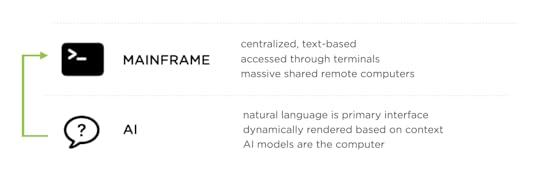Platform Shifts Redefine Apps
With each major technology platform shift, people underestimate how much "what an application is and how it's built" changes. From mainframes to PCs, to Web, to Mobile and now AI, computing platform changes redefined software and created new opportunities and constraints for application design and development.
These shifts not only impacted how applications work but also where they run, what they look like, how they're built, delivered, and experienced by people.
Mainframe era: Applications lived on massive shared computers in climate-controlled rooms, with people typing text-only commands into terminals that were basically windows into a distant brain. All the intelligence sat somewhere else, and you just got text back.
PC era: Software became physical products you'd buy in boxes, install from floppy disks or CDs, and run entirely on your own machine. Suddenly computing power lived under your desk, and applications could use rich graphical interfaces instead of just green text on black screens.
Web era: Applications moved into browsers accessed through URLs, shifting from installed software to services that updated automatically. No more version numbers or install wizards, just type an address and you're using the latest version built out of cross-platform Web standards UI components.
Mobile era: Applications shrank into task-focused apps downloaded from curated stores, designed for fingers not mice, and aware of your location and orientation. Computing became something in your pocket that could make use of the environment around you through cameras, GPS, and on-device sensors.
AI era: Instead of screens and buttons, applications are conversations where AI models understand intent, execute complex tasks, and adapt to context without explicit programming for every scenario. And we're just getting started.
While it's true that AI applications sound a lot like the mainframe applications of old, those apps required exact syntax and returned predetermined responses. AI applications understand natural language and generate solutions on the fly. They don't just process commands, they reason through problems and build UI as needed.
During each of these platform shifts, companies react the same way. They attempt to port the application models they had without thinking through and embracing what's different. Early Web site were posters and brochures. Early mobile apps were ported Websites. Just like early TV shows were just radio shows with cameras pointed at them.
But at the start of a technology platform shift, how applications will change isn't clear. It takes time for new forms to develop. As they do most companies will end up rebuilding their apps like they did for the Web, mobile, and more. Companies that embrace new capabilities and modes of building early on can gain a foothold and grow. That's why technology shifts are accompanied by a surge of new start-ups. Change is opportunity.
Luke Wroblewski's Blog
- Luke Wroblewski's profile
- 86 followers





